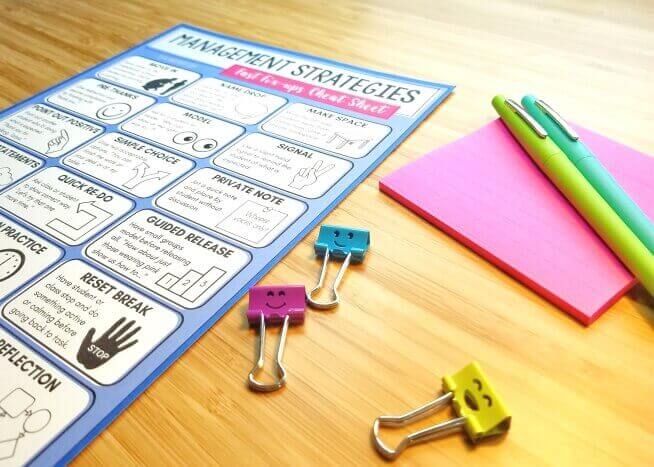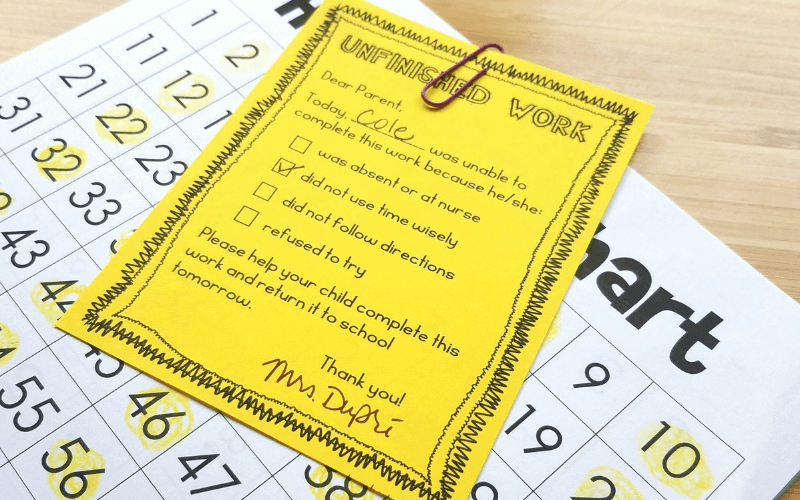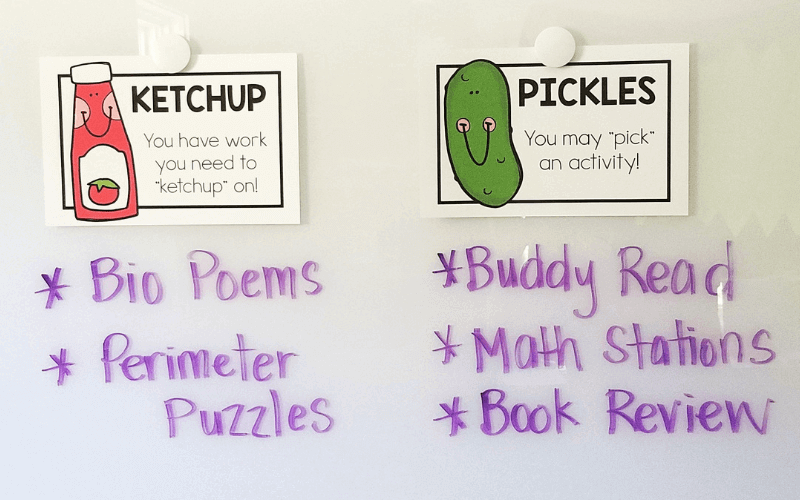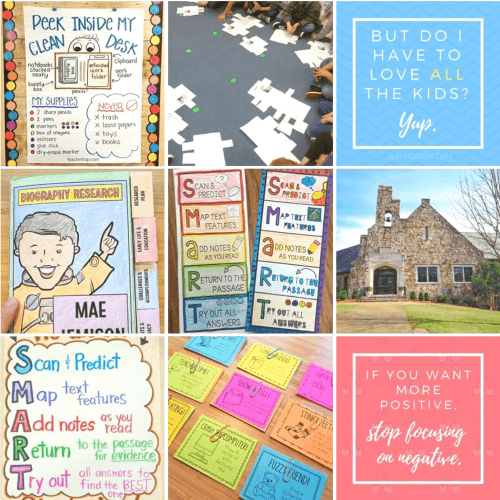Unfinished student work is an ongoing challenge in any classroom. I’ve seen teachers in tears because a student ‘just won’t get anything done.’ I’ve seen teachers lose their temper because they are trying to so hard to get students caught up. And I’ve seen teachers with complicated forms for organizing who owes what work. Seen it, done it, over it.
You don’t need a personal assistant to manage all that madness. Just two simple solutions and unfinished work drama is a thing of the past.
The Unfinished Work Notice
These simple little notes are a major game-changer. I keep them printed and ready to pull out as needed, but to be honest, once I’ve used one with a student, I almost never need to again! I love these notes so much, I’ve included them in both the Positive Parent-Teacher Partnerships Course AND the Classroom Management Makeover Program.
At the beginning of the year, I have a discussion with the class about the work we’ll be doing and the importance of time management. I explain that I’ll always give them enough time to complete work, I’ll always provide support and help when needed, and that I’ll always do my best to break down big tasks into manageable parts and give reminders about remaining time. Those things are my job. Their job is to stay focused and do their best work (even if something is tricky or not their favorite task).
Then I show them the Unfinished Work Notice and I explain that sometimes things might happen that keep students from finishing their work. A student might get sick one day and need to go to the nurse. A student might start playing around and not use their time wisely. Or a student might feel frustrated or not want to do something. Last, I explain that I understand how all these things might happen, but in the end, what’s most important to me is their LEARNING.
So if for some reason, the work can’t be completed at school, we’ll just use the Unfinished Work Notice. I simply fill it out, staple it to the work, and send it home. The work is due back the next day with a parent signature.
WHY THIS WORKS
It’s quick! When I use an Unfinished Work Notice, there is no discussion or arguing. I quickly attach the note and move on. This helps eliminate lengthy conversations about why work wasn’t finished or who is to blame or why a student doesn’t want to do it.
It’s fair! I make sure students understand that this is not a punishment, but simply a way to make sure they don’t miss out on important learning. If the work can’t be finished at school, then it has to be finished at home.
It’s a deterrent! Kids don’t want to take the work home, so knowing that this is the next step helps keeps students on track and focused. They realize that the work will be completed at some point so it’s smarter to get it done at school.
TROUBLE-SHOOTING TIPS
These notes work wonders for students who tend to waste time and for students who tend to argue and try to refuse work. Typically, once I send one home with a child, we rarely have an issue again. BUT, if you find you’re having to use them daily or even weekly with the same child, then it’s time to stop and rethink the situation. What is the underlying issue that needs to be addressed?
You might also put something in place for what happens when a child takes the work home but doesn’t return it completed. What will your next step be? I typically contact the parent at that point and let them know the work will be coming home a second night and needs to be completed.
*IMPORTANT: These notes should NOT be used for students who are struggling with the material or task. If a child has not completed work because they do not understand or have the skills to do so, interventions or modifications should be provided.
Ketchup and Pickles
If you haven’t already heard of Ketchup and Pickles Time, you’re in for a treat! Not the edible kind, don’t worry. All you do is set aside a chunk of time each Friday for students to “catch-up” on unfinished work or “pick” from a variety of options. I find that 20 minutes works well but you could adjust to 15 or even 30, depending on your schedule.
During this time, some students are completing unfinished work while others pick from enrichment choices or activities. This allows the teacher to provide individual or small group support to those students working to catch up.
You can download the “Ketchup and Pickles” cards for free in my TPT Store here.
WHY THIS WORKS
This strategy gives students awesome motivation during the week because they are excited about “Pickles” and don’t want to waste time with “Ketchup.” During the time itself, students are also motivated because once they finish with their catch-up work, they can move on to a “Pickle!”
Plus, because you have a built-in time, you’re able to get all students caught up with any unfinished work BEFORE you move into the next school week.
I typically include the same set of Pickles each week, occasionally adding in special choices from time to time. My standard Pickles are Buddy Reading, Buddy Writing, Math Fact Practice (games or tech), Book Reviews, and sometimes helping the teacher with class jobs such as cleaning, passing back papers, etc.
I was able to essentially eliminate unfinished work drama with these simple strategies. What have you found to work best? Share your favorite tips with us!












I don’t know why I hadn’t thought of setting aside some time at the end of the week for “unfinished work” and pickles (choice activity) for those completed. Love it! Thank you, glad someone is more organized than me!
Oof! I understand you mention you wouldn’t necessarily do this if a kid is struggling, but alarm bells are going off for me re: undiagnosed disabilities. What if a child “isn’t using time wisely” and has an undiagnosed executive functioning disorder or a learning disability? As a mom of a child with ADHD and tics who advocates yet the school says my child’s grades are “fine” and won’t grant an IEP, and doesn’t ever consider behaviors (ex. Talking out or not staying on task) to be due to his disability, this is a huge red flag. Just send the work home saying the child didn’t finish it.
Absolutely, Rebecca! Great point! This strategy is meant to be used in a nonpunitive way and should only be used occasionally with any given student. In a situation where a child is often struggling to stay on task or complete work, the teacher would need to determine the cause and collaborate with parents to come up with a plan that supports that child.